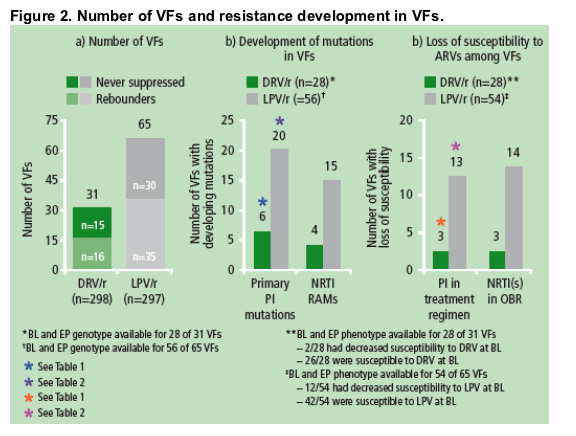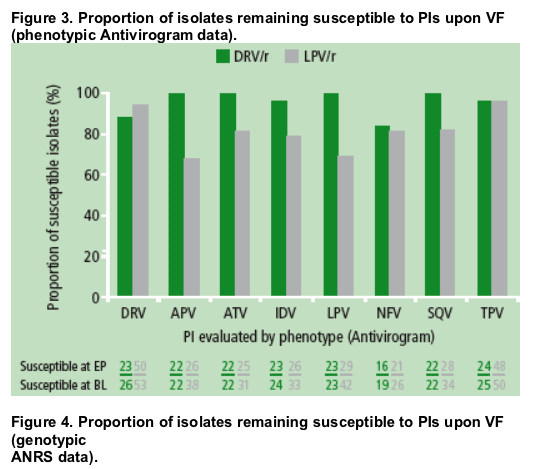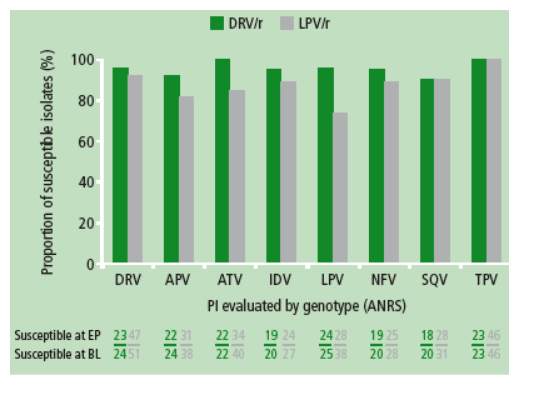 |
 |
 |
| |
Characterization of virologic failures on darunavir/ritonavir in the randomized, controlled, Phase III TITAN trial in treatment-experienced patients
|
| |
| |
Reported by Jules Levin
CROI 2008 Boston
Sandra De Meyer,1 Erkki Lathouwers,1 Inge Dierynck,1 Els De Paepe,1 Ben Van Baelen,1 Tony Vangeneugden,1 Sabrina Spinosa-Guzman,1 Gaston Picchio,2 Marie-Pierre de Bethune1
1Tibotec BVBA, Mechelen, Belgium; 2Tibotec Inc., Yardley, PA, USA
AUTHOR CONCLUSIONS
· In this LPV-naive, treatment-experienced TITAN patient population, twice as many patients receiving LPV/r had viral failure (VF) compared with those receiving DRV/r.
· Fewer VFs receiving DRV/r developed primary PI mutations and NRTI RAMs compared with VFs receiving LPV/r.
· More VFs on LPV/r than on DRV/r lost susceptibility to any other PI. Among the DRV/r VFs, the majority retained susceptibility to PIs. The findings based on phenotypic data (Antivirogram) were also confirmed by genotypic interpretation (ANRS).
· In summary, these TITAN study findings suggest that
- DRV/r is more effective than LPV/r
- upon VF, DRV/r is better than LPV/r in preventing the development of resistance
- cross-resistance between DRV and other PIs was less frequent than that of LPV in this population of less treatment-experienced patients.
INTRODUCTION
· The emergence of resistance to highly active antiretroviral therapy (HAART) presents a significant challenge to managing HIV-1 infection. Characterizing the development of resistance to new antiretrovirals (ARVs) is needed to help improve treatment decisions.
· The new HIV-1 protease inhibitor (PI) darunavir (DRV; TMC114) has significant in-vitro ARV activity against both wild-type virus and multidrug-resistant HIV-1 strains.1 DRV has a high genetic barrier, which delays the development of resistance and allows the retention of antiviral activity despite the occurrence of mutations within the target viral protein.
· DRV with low-dose ritonavir (DRV/r) at a dose of 600/100mg bid has been approved in the USA2 and the EU3 for the treatment of HIV-1 infection in treatment-experienced adult patients.
· In the ongoing Phase III TITAN trial (TMC114-C214), results of the 48-week primary analysis showed that treatment with DRV/r 600/100mg bid achieved both primary (noninferiority) and secondary (superiority) virologic endpoints versus lopinavir/ritonavir (LPV/r) 400/100mg bid in patients with a broad range of treatment experience.4
· At Week 48 in the TITAN trial, 71% of DRV/r patients achieved full virologic suppression (HIV RNA <50 copies/mL) compared to 60% of LPV/r patients.4
· The present analyses characterized the development of resistance in TITAN patients experiencing virologic failure (VF) with DRV/r or LPV/r.
METHODS
Design and patient population
· TITAN is an international, randomized, controlled, 96-week, ongoing Phase III trial designed to assess the efficacy and safety of DRV/r versus LPV/r in LPV-naive, treatment-experienced, HIV-1-infected patients.4
· Patients with HIV-1 RNA >1000 copies/mL and treated with their current HAART for >/=12 weeks were randomized to receive either DRV/r 600/100mg bid or LPV/r 400/100mg bid, plus an optimized background regimen (OBR, at least two ARVs [NRTIs and/or NNRTIs]; enfuvirtide (ENF) was disallowed) (Figure 1). Initially, patients on a structured treatment interruption of >/=4 weeks were also permitted to enroll.
· Patients with previous or current use of LPV, DRV, tipranavir (TPV) or ENF and current use of investigational ARV drugs were excluded from the trial.
Virologic analysis
· Analyses were performed on the dataset from the primary analyses with a cut-off date of 17 January 2007, when all patients had reached Week 48 of treatment or discontinued earlier.
· VFs were defined as rebounders (loss of HIV-1 RNA <400 copies/mL) and never suppressed patients (never achieved HIV-1 RNA <400 copies/mL). Moreover, patients who discontinued before Week 16 were not taken into account to determine VF.
· The time-to-loss of virologic response (TLOVR; non-VF censored) imputation method was used for the analysis of virologic response, meaning that data were not imputed at timepoints after discontinuation for patients who discontinued for reasons other than VF (non-VF).
· Viral phenotypic (Antivirogram) and genotypic determinations were performed by Virco BVBA (Mechelen, Belgium).
· Phenotypic resistance was defined as having a fold-change in EC50 (FC) above the biologic/clinical cut-off (Antivirogram). The clinical cut-off of 10 was used for both DRV5 and LPV6, and 3 for TPV.7 The biologic cut-offs 2.2, 2.4, 2.4, 2.2 and 1.8 were used for amprenavir (APV), atazanavir (ATV), indinavir (IDV), nelfinavir (NFV) and saquinavir (SQV), respectively.
· All lists of mutations were based on the IAS-USA lists.8
· The development of resistance at endpoint (EP; i.e. the last available timepoint with a genotype/phenotype during the treatment period) compared with baseline (BL) was studied in patients who experienced VF
- the development of a mutation was defined as the detection of a mutation by resistance testing at EP, but not at BL
- the loss of susceptibility to an ARV was defined as having a FC above the biologic/clinical cut-off at EP while not at BL.
· In parallel with the phenotypic analysis, a genotypic interpretation was performed using the Agence Nationale de Recherches sur le Sida (ANRS) system HIV-1 genotypic drug resistance interpretation algorithm of 2007.9
RESULTS
Baseline characteristics
· Of the 595 patients who were randomized and treated, 31% had not used PIs previously. A total of 82% of BL isolates were susceptible to >/=4 PIs.
· BL characteristics were similar between the two treatment groups with
a median of 0 primary PI mutations, 4 PI resistance-associated mutations (RAMs) and 2 NRTI RAMs, a median FC of 0.6 for DRV and 0.75 for LPV, and a median phenotypic sensitivity score of the underlying therapy of 2.10
Virologic failures
· More patients receiving LPV/r failed to respond to treatment or experienced rebound, compared with those patients receiving DRV/r. The VF rate with LPV/r was two-fold higher than with DRV/r (Figure 2a).

· Fewer VFs on DRV/r than on LPV/r developed primary PI mutations or NRTI RAMs (Figure 2b).
· In the DRV/r group, 6 VFs developed a primary PI mutation (Figure 2b)
- in 1 of the 6 DRV/r VFs, the L90M mutation that was detected at EP and not at BL was already detected in the screening sample
- in the other 5 VFs, the following primary PI mutations (all DRV RAMs) developed: V32I (in 3 patients), I47V and L76V (in 2 patients) and I54L (in 1 patient). The 5 patients had previously used 2-6 PIs.
· In the LPV/r group, 20 VFs developed a primary PI mutation (Figure 2b)
- in 1 of the 20 LPV/r VFs, the primary PI mutation M46I that was detected at EP and not at BL was already detected in the screening sample
- in the other 19 VFs, the following primary PI mutations developed: M46I (in 6 patients), M46L and L76V (in 4 patients), L33F, I47A, I47V, V82A and I84V (in 2 patients) and V32I, I50V and I54M (in 1 patient). All these mutations are described as LPV RAMs.11
· Based on Antivirogram, in the DRV/r group, 3 VFs lost susceptibility to DRV; in the LPV/r group, 13 VFs lost susceptibility to LPV (Figure 2c).
· Among the DRV/r VFs, the majority retained susceptibility to PIs, based on phenotypic Antivirogram data (Figure 3). More VFs on LPV/r than on DRV/r lost susceptibility to the PI studied or any other PI (Figure 3).
· The same conclusion could be drawn from the ANRS HIV-1 genotypic drug resistance interpretations instead of the phenotypes (Figure 4).


REFERENCE
1. De Meyer S, et al. Antimicrob Agents Chemother 2005;49:2314-21.
2. Tibotec Inc. PREZISTATM (darunavir) Prescribing Information. October 2006 [accessed January 3, 2008]. Available from: http://www.prezista.com.
3. PREZISTATM (darunavir) Summary of Product Characteristics. February 2007 [accessed January 3, 2008]. Available
from: http://www.emea.europa.eu/humandocs/PDFs/EPAR/prezista/H-707-PI-en.pdf.
4. Madruga JV, et al. Lancet 2007;370:49-58.
5. De Meyer S, et al. 15th International HIV Drug Resistance Workshop, Sitges, Spain, 13-17 June 2006. Abstract 73.
6. Abbott Laboratories. Kaletra (lopinavir/ritonavir) Prescribing Information. April 2005 [accessed January 3, 2008].
Available from: http://www.kaletra.com.
7. Boehringer Ingelheim. APTIVUS (tipranavir) Prescribing Information. October 2007 [accessed January 22, 2008].
Available from: http://www.aptivus.com.
8. Johnson VA, et al. Top HIV Med 2006;14:125-30.
9. HIV French Resistance. HIV-1 genotypic drug resistance interpretation's algorithms. [accessed January 22, 2008].
Available from: http://www.hivfrenchresistance.org/2007/tab2.html.
10. De Meyer S, et al. 11th European AIDS Conference, Madrid, Spain, 24-27 October 2007. Abstract P7.3/04.
11. Johnson VA, et al. Top HIV Med 2007;15:119-25.
|
| |
|
 |
 |
|
|